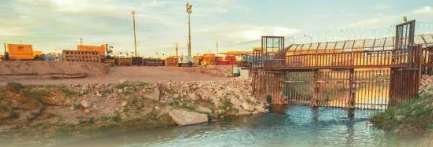New River Improvement Project marks milestone
with groundbreaking ceremony in Calexico
May 26, 2023
Media Contact: Kalin Kipling-Mojaddedi, California Environmental Protection Agency, kalin.kipling@calepa.ca.gov

A project to improve water quality in the New River as it crosses into California from Mexico broke ground in Calexico today. This milestone reflects years of collaborative advocacy, and nearly $48 million in investments from the state of California.
The New River is considered one of the most polluted rivers in the nation. Trash and waste from municipal, agricultural and industrial sources cause heavy pollution throughout the New River, which runs from Mexico through the city of Calexico to the Salton Sea. It poses serious threats to public health and hinders local economic development.
The predominately Latino community where the project will be located ranks in the 95th percentile for cumulative environmental impacts, including in the 92nd percentile for pollution burden and 100th percentile for impaired waters, according to CalEnviroScreen, California’s groundbreaking environmental justice mapping tool.
The New River Improvement Project consists of three primary components:
- Construction of a trash screen at the International Boundary with Mexico.
- Diversion and encasement of the river from a point downstream of the International Boundary to a point downstream of the eastern boundary of Calexico to bypass the populated southern area of the city.
- Construction of a pump-back system to take treated wastewater from the existing City of CalexicoWastewater Treatment Plant and discharge it into the New River channel at a point near the proposed river diversion and encasement structure.
Today’s groundbreaking is years in the making and is a key step forward in protecting the environment and public health in the region.
Learn more in this factsheet.
WHAT PEOPLE ARE SAYING
“The New River has been one of the most polluted rivers in the nation, long threatening public health and the well-being of communities that live along its boundaries in the California-Mexico border region,” said California Secretary for Environmental Protection Yana Garcia. “Following nearly $48 million in investments from the state of California, today, the city of Calexico is breaking ground on a project that will advance environmental justice and improve water quality in the region. The New River Improvement Project is the direct result of years of advocacy from communities on the ground and the steadfast support of the local leaders, state agencies, and the Legislature. To all our partners in these efforts, thank you.”
“The New River Improvement Project is a great example of local and state partners working together to support our communities as we build climate resiliency,” California Secretary for Natural Resources Wade Crowfoot said. “We are proud to continue California’s investment in projects that achieve multiple benefits, including protecting the health and safety of Calexico residents and addressing threats to our environment.”
“The New River Improvement Project in California’s desert border region is a monumental move toward the commitment of improving environmental health in one of California’s most vulnerable populations,” said City of Calexico Mayor Raúl Ureña. “The West Side of Calexico, up by the riverbanks, where migrant attempts to swim across waters too polluted for Customs Officers to enter are a common occurrence, where runoff from the international economy seriously pollute this river; a truly binational effort to improve water quality gains traction for a better and more just Calexico border region.”
“Investing in our sanitation and drinking water systems is critical for the health and vitality of our communities,” said State Water Resources Control Board Chair E. Joaquin Esquivel. “Thanks to sustained leadership across local and state agencies, this key improvement to the life and quality of community is a reality.”
“Department of Water Resources is proud to support collaborative projects like this that improve water quality and water supply for communities and the environment,” said California Department of Water Resources Lead Deputy Director Cindy Messer. “We look forward to supporting additional efforts that will provide multiple benefits for all.”
“Years of steadfast community advocacy, collaborative partnerships, and a nearly $48 million investment from the State of California have brought the New River Improvement Project to reality. Generations of Imperial County residents living alongside our southern border have raised their voices on the urgent New River public health and environmental crisis — efforts that have finally gained momentum thanks to the attention of Governor Newsom’s administration and the leadership of the California Environmental Protection Agency and Natural Resources Agency,” said Assemblymember Eduardo Garcia, who fought to accelerate action and secure funding for New River and border river solutions. “The groundbreaking of the New River Improvement Project is a community triumph and environmental justice milestone.”
California Air Resources Board • Department of Pesticide Regulation • Department of Resources Recycling and Recovery (CalRecycle) • Department of Toxic Substances Control • Office of Environmental Health Hazard Assessment • State Water Resources Control Board • Regional Water Quality Control Boards
CalEPA, 1001 I Street, Sacramento, CA 95814 • P.O. Box 2815, Sacramento, CA 95812 • (916) 323-2514 www.calepa.ca.gov
“The New River has been one of the most polluted rivers in the nation, long threatening public health and the well-being of communities that live along its boundaries in the California-Mexico border region. Following nearly $48 million in investments from the state of California, today, the city of Calexico is breaking ground on a project that will advance environmental justice and improve water quality in the region. The New River Improvement Project is the direct result of years of advocacy from communities on the ground and the steadfast support of the local leaders, state agencies, and the Legislature. To all our partners in these efforts, thank you.”

